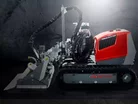Aquajet Systems introduces the world’s smallest hydrodemolition robot

Aquajet Systems AB has created the world’s smallest hydrodemolition robot, the Aqua Cutter 410V. The model’s versatility enables the robot to work in tight spaces, with extended reach in horizontal, vertical and overhead applications. It’s design also makes it suitable for a wide variety of concrete removal tasks, such as renovation and bridge and road repair.
“We provide contractors the ability to work in confined spaces while improving safety and productivity,” said Roger Simonsson, Aquajet Systems Managing Director. “This means less risk for contractors, higher ROI and more successful jobsites.”
How does it work?
Weighing 2,756-pound (1,250-kilogram) the robot uses 15,000-40,000-psi water jets to efficiently remove as much as 9 cubic feet (.25 cubic meters) per hour of concrete. Contractors adjust the robot’s stroke to control the depth of cuts, and vary the water pressure depending on whether they are removing loose, deteriorated concrete from the sound concrete below, or sound concrete to a pre-determined depth. The process has the added benefit of cleaning and descaling the rebar, whereas alternative methods, such as pneumatic tools or milling machines, may damage the rebar or produce microfracturing in the remaining concrete.
Operators can control the robot from a safe distance using the unit’s radio remote control, which communicates with the robot’s wheeled power control module. Contractors can remove the module from the tracked portion to reduce the crawler to a third of its original size and create an even more compact robot. This provides the ability to drive the crawler into tight and inhospitable environments, such as small tunnels and flooded sewer pipes, while the module remains connected via a cord.
The highly-efficient ceramic nozzles last 300-350 hours, depending on the water quality. In comparison, standard steel nozzles used on competitive equipment last 20-40 hours.



